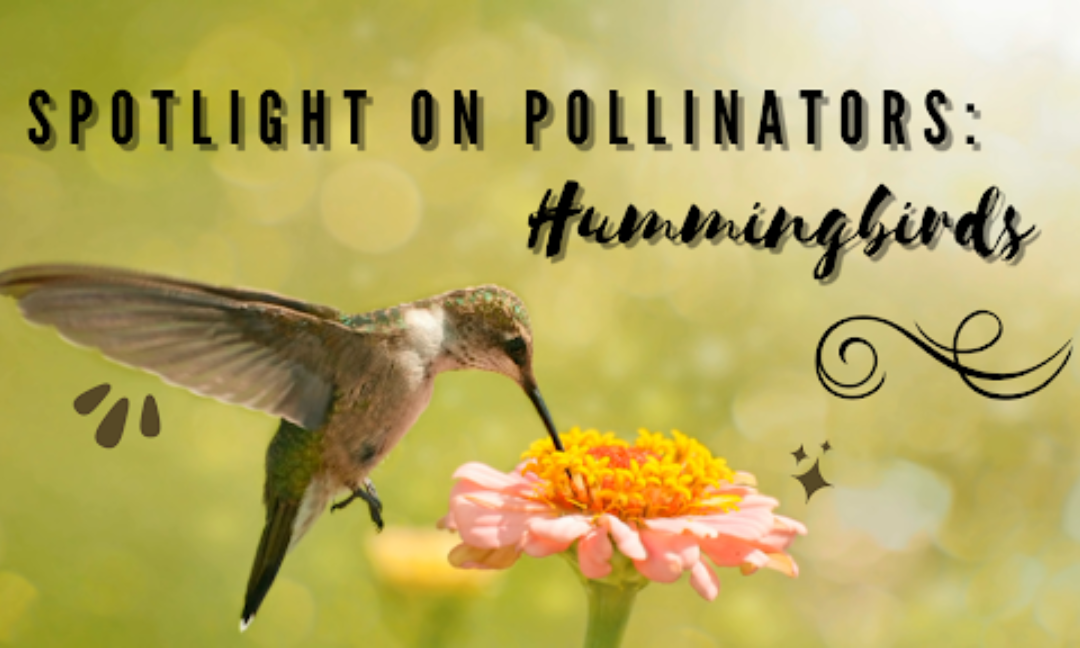Spotlight On Pollinators: Hummingbirds
Written By: Tahreem N
Edited By: Kayla Mcmichael
Designed By: Tahreem N
Published By: Samantha Porte
What are hummingbirds?
Hummingbirds are conceivably one of the most captivating and interesting backyard birds. But what is it that makes these creatures so special and different from other birds?
The world is filled with almost than 340 hundred species of hummingbirds, most of which are native to all of America and part of Canada including the provinces of Nova Scotia (including Cape Breton Island), New Brunswick, Prince Edward Island, southern Quebec, and Ontario north to Lake Nipigon and Lake of the Woods.
Furthermore, hummingbirds can come in many unique shapes and sizes. Some are known as the smallest birds in the world whereas others are known as the biggest bird species in the world. Aside from their size, a hummingbird’s most noticeable physical feature that allows them to instantly be identified is their long, narrow bills and bright colours.
Although hummingbirds have long and slender wings which they use to fly, their feet are very small which restricts the birds from walking, resulting in them being dependent on their wings. On the other hand, though they may not be able to walk, they have a special skill that other birds don’t have: being able to fly in any direction!
How Flowers Attract Hummingbirds:
Though bees are considered the most important pollinators, there are many others like butterflies, beetles, wasps, ants, moths and hummingbirds. But what is pollination? In short, pollination is the process which allows a plant to reproduce. In some cases, rain or strong winds cause pollen to blow between plants and transfer to the plant’s reproductive part. Most plants need pollinators like bees, butterflies or hummingbirds to pollinate from one plant to another.
Since hummingbirds are constantly eating, they are the perfect pollinators for certain flowers. Red, pink, yellow, and orange flowers that have colourful patterns are all attractive to hummingbirds. Since birds can see colour along a greater spectrum, ultraviolet shades can also play a role in attracting hummingbirds. Aside from colour, the shape can also affect their choosings. Long tubular flowers are perfect for a hummingbird’s bills and can hold large amounts of nectar.
How Hummingbirds Pollinate:
Hummingbirds pollinate each flower, flowering shrub, and blooming tree in a specific way. Since hummingbirds feed on nectar around 5-8 times every hour and probably visit hundreds of flowers a day, there’s plenty of chances for a single bird to pollinate multiple flowers a day using unique methods such as simple distribution, bill transfer, and head transfer.
Simple distribution is when pollen grains near a flower lead to successful pollination. When a hummingbird nudges a flower with its bill or creates a breeze with its wings, that disruption may be enough for pollination to occur. Bill transfer and head transfer are different from simple distribution.
Bill transfer is when pollen sticks to the beak of a hummingbird when it’s drinking the nectar. Then, when the bird visits a different flower, that pollen is then absorbed by that new flower.
The flowers that hummingbirds prefer are often very deep for them to reach with their beaks. When the hummingbird’s head brushes against the anther of the flower, chances are that the pollen is now stuck to its head and will probably transfer to the next flower it visits, thus presenting head transfer.
How You Can Help Hummingbirds:
You can easily help hummingbirds with their pollination duties and also get a beautiful and lucious garden in your backyard. For example ,you can assist hummingbirds with their pollination duties by:
- Designing a hummingbird garden with vertical layers and tiers for easy flower access.
- Planting flowers that are potentially attractive to Hummingbirds, to receive more visits.
- Avoiding the use of chemicals in your flower garden that can discourage the hummingbirds from visiting your garden.
- Garden hummingbird feeders can be installed. More hummingbirds in your yard means greater opportunities for pollination, and these can draw more birds to your yard.
Hummingbirds have various characteristics that set them apart, including their geographic distribution, outward-facing characteristics, and behavioural traits. Birders can enjoy seeing these avian gems even more by having a better understanding of what a hummingbird is.
________________________
Works Cited
Mayntz, M. (2021, March 13). What qualities make a hummingbird unique? The Spruce.
Retrieved August 31, 2022, from
https://www.thespruce.com/what-is-a-hummingbird-387114
Mayntz, M. (2021, September 19). This is how hummingbirds pollinate plants and flowers. The Spruce. Retrieved August 31, 2022, from https://www.thespruce.com/hummingbirds-and-pollination-386469
Byland, S. (n.d.). Hummingbirds. Encyclopædia Britannica.
Retrieved August 31, 2022, from
https://kids.britannica.com/kids/article/hummingbird/353273
Lawrence, kiriline. (n.d.). Ruby-throated hummingbird. Hinterland Who’s Who – Ruby-throated Hummingbird.
Retrieved August 31, 2022, from
https://hww.ca/en/wildlife/birds/ruby-throated-hummingbird.html
blogger, G. (2021, August 5). Which wild pollinators are in decline and why? Ontario Nature. Retrieved August 31, 2022, from https://ontarionature.org/which-wild-pollinators-are-in-decline-and-why/
Hummingbirds. Smithsonian’s National Zoo. (2018, May 7).
Retrieved August 31, 2022, from
https://nationalzoo.si.edu/migratory-birds/hummingbirds
Kid’s Guide to Flower Pollination. Kremp Florist. (n.d.).
Retrieved August 31, 2022, from
https://www.kremp.com/pollination-for-kids/

